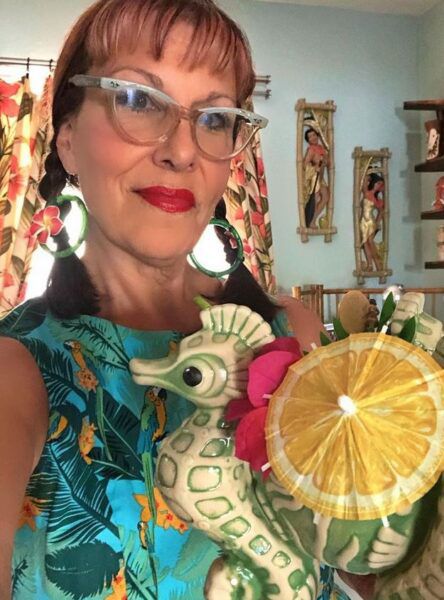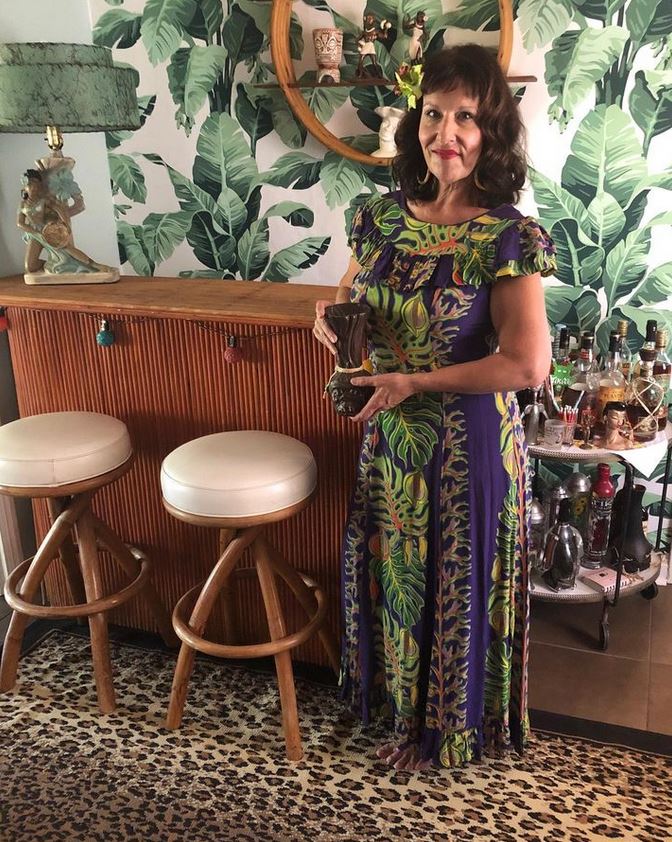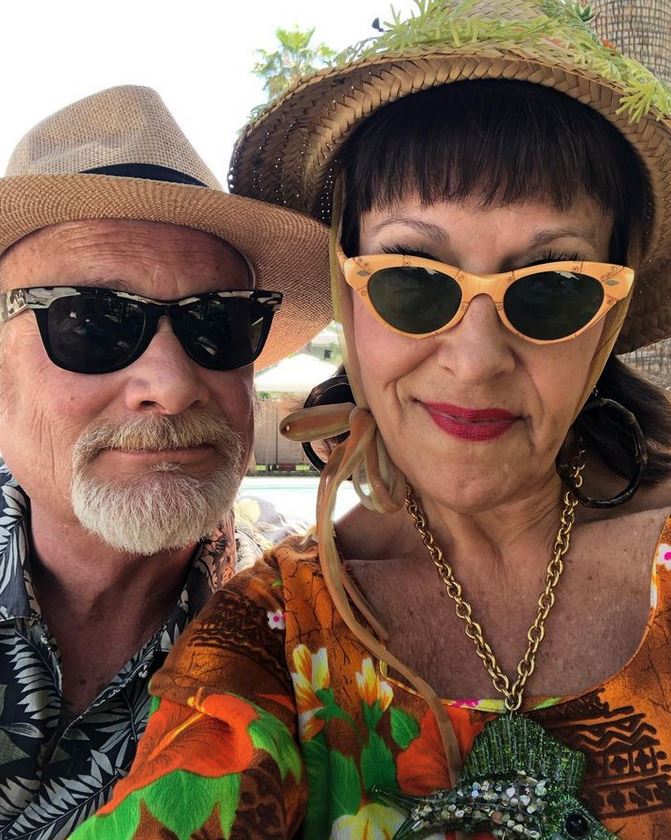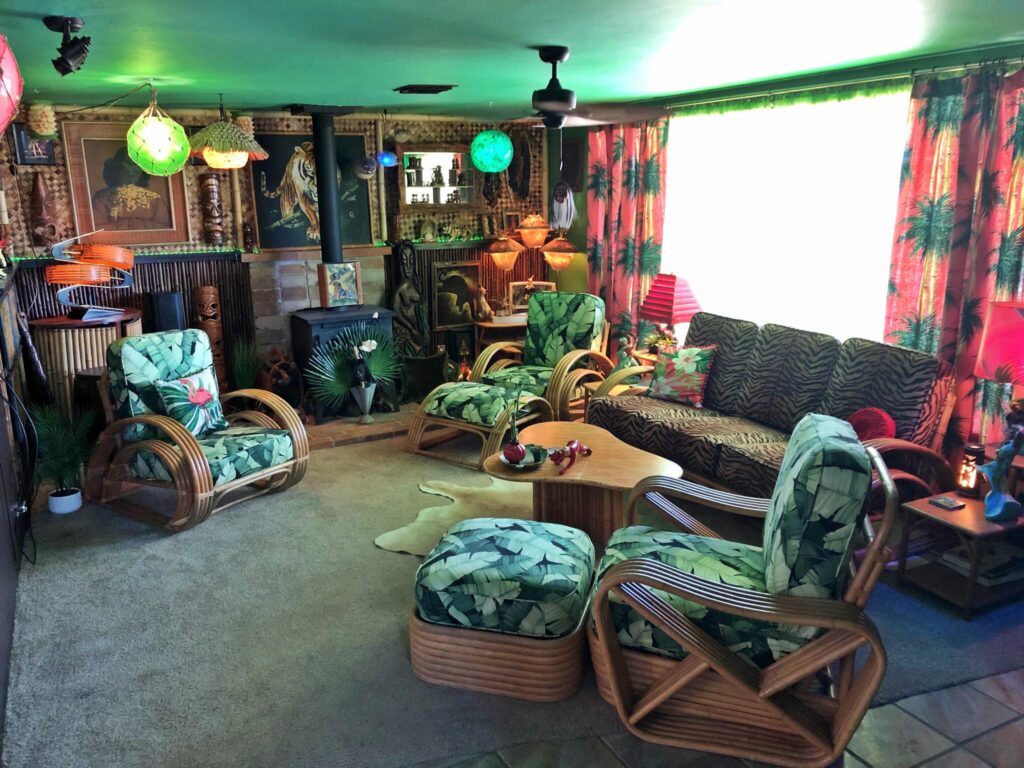#Kym #Shoobashooba #Adams #Adopted #Ultimate #Tiki #Lifestyle #WorthPoint
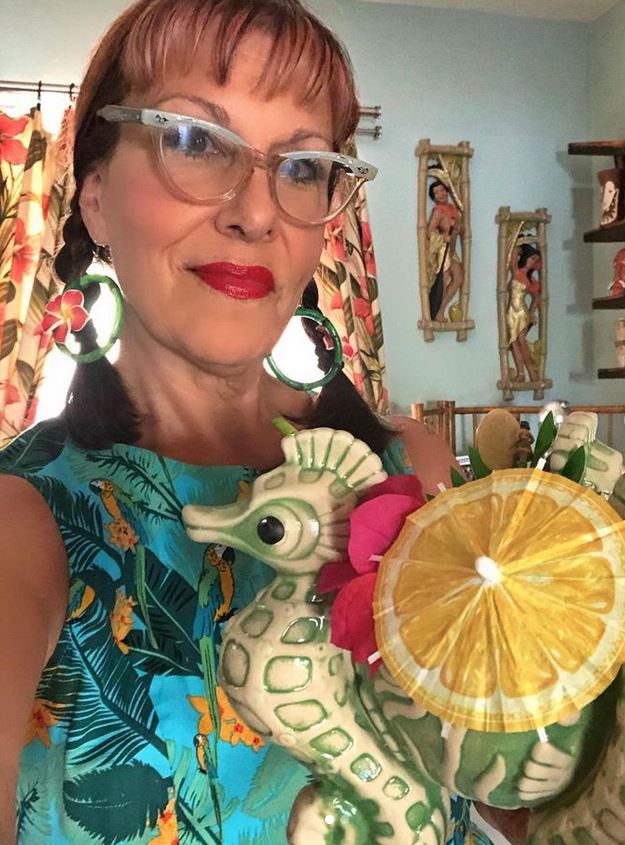
Photo courtesy: Kym Adams
America’s love affair with all things tiki began in the 1940s when returning soldiers in the Pacific Theatre—many of whom were initially stationed in Hawaii—brought or sent tropical textiles and tchotchkes to loved ones back home. Rather quickly, the rest of the country fell in love with the island vibe, incorporating it into their fashion, home décor, furniture, barware, textiles, and every other conceivable product.
TASTE OF THE TROPICS
At tiki culture’s 1950s to 1960s peak, rattan furniture covered in banana leaf print cushions adorned many a patio. Tiki restaurants began popping up in big cities—including famous ones like Don the Beachcomber and Trader Vic’s in Los Angeles, Sip ‘N Dip Mermaid Bar and Tiki Lounge in Great Falls, Montana, and Tonga Room and Hurricane Bar in San Francisco. Drinks like mai tais, margaritas, and piña coladas became as favored as the old stalwarts, beer and wine. For a good twenty-plus years, tiki culture reigned supreme in virtually every facet of American life.
By the late 1960s–early 1970s, amid the Vietnam War, a more bohemian, less showy aesthetic took over, sidelining the tiki look and feel as an unwelcome fantasy. In the late 1970s, singer Jimmy Buffett (RIP!) singlehandedly reintroduced the idea of island life—sipping margaritas on the beach, free of any responsibility—via his 1977 hit single, “Margaritaville.” Called “Parrot Heads,” Buffett fans donned Hawaiian shirts and coconut bras whenever his concert tours rolled into town—a moment of escapism before reverting back to reality. Beyond Buffett and occasional island vacations, little love was shown to tiki for the next thirty-plus years.
That is until a new, post-boomer generation rediscovered the beauty and magic of decorating, dressing, and drinking tiki like their grandparents before them. Along with the allure of mid-century modern (MCM), tiki décor returned in vogue in the new millennium. Tropical fans added bamboo tiki bars to their homes. They played vintage Hawaiian music during cocktail parties, dressed in Hawaiian print, collected tiki memorabilia, and hung tropical wall art.
ESCAPE THE ORDINARY
One of today’s high priestesses of tiki is a Seattle native-turned-Tucson transplant known simply as “Shoobashooba.” Kym Adams—the definition of commitment—has embraced every facet of the tropical lifestyle. Her home is a veritable ode to vintage Polynesian resorts. Along with her husband, she dresses in Hawaiian prints, travels to tiki restaurants around the world, and samples every tropical drink known to mankind. The sheer amount of tiki glasses and mugs she owns is almost as impressive as her rattan furniture collection. For any grieving Parrot Heads or MCM collector looking to go full-time tropical, follow the lead of Kym “Shoobashooba” Adams—a self-described “tiki aficionado and aspiring bartender with a vintage lamp problem.”
Q. First off, what the heck is “Shoobashooba?”
A. It’s a silly story, really. In the beginning days of eBay, I was a seller, but every handle I tried was already taken. In total frustration, I yelled at my computer, “OK—how about ‘Shoobashooba?’” Not surprisingly, no one had taken that one. It’s been my handle for everything since.
Q. When did you start collecting vintage?
A. At the age of six. My very young and stylish aunt—whom I adored—offered me her jewelry box full of amazing costume jewelry. I was thrilled! After taking some for myself, I sold the rest in her front yard. I’ve been a collector and seller ever since.
TROPICAL HEATWAVE
Q. Aside from your aunt, what was your inspiration in the early days?
A. At a young age, I watched the Marilyn Monroe movie Niagara. I fell in love with her style, but mostly her clear Lucite handbag. I began the vintage hunt for them, and I’ve owned many Lucite handbags over the years.
Q. Where do you find most of your items?
A. My absolute favorite has always been flea markets. I try to find them even when I’m traveling.
Q. Your love of all things tropical and tiki goes beyond average collecting—it’s a lifestyle you’ve fully embraced. What is it about this aesthetic that has resonated with you?
A. Escapism. If you can’t be there, why not recreate it? It helps that I’ve moved out of the cold and grey of Seattle to the sun and palm trees of Arizona. I also fell in love with the style of the islands—the Caribbean, Mexico, and Cuba, especially after traveling there.
PERMANENT VACATION
Q. When did you move from simply collecting tiki stuff to living the lifestyle?
A. I never liked the weather in the northwest most of the year, and I always longed for palm trees and sunshine. In the 1980s, my husband and I were Jimmy Buffet Parrot Heads. We traveled to the places he sang about: the Caribbean islands, Key West, Mexico. He was our gateway drug to tiki. We eventually built a makeshift tiki bar in our yard and threw tiki parties. We met new friends who were really into tiki, and they invited me on a bus tour of peoples’ homes with elaborate basement tiki bars. I was floored. I became determined to create my own tropical fantasy. It was easy to do that because, at that time, there had been a huge resurgence in the tiki scene, with amazing books on the subject coming out, vintage clothes and décor, hand-crafted cocktails, and tiki weekenders. I started collecting all of these things.
Q. What are your favorite pieces to collect?
A. Probably tiki-style lamps. I am known as the crazy lamp lady.
Q. What is your oddest or most unique piece overall?
A. I had a client whose father was stationed in Hawaii during WWII. His favorite watering hole had a very large painting of a snarling tiger in a bamboo frame that he adored. He always told the bar owner he’d love to have it until the owner finally gave it to him. After her father died, my client inherited it, but her husband hated it, and it sat hidden in the garage for years. She ultimately offered it to me. At the time, I had no room for it, but how could I pass that up? It’s now hanging in my tiki bar as a focal point. I love it!

Photo courtesy: Kym Adams
IT’S TIKI O’CLOCK SOMEWHERE
Q. What are your favorite tropical drinks? How do you like to serve them?
A. I would say the mai tai and the zombie are my favorites. I do collect vintage barware, but very few of my mai tai and zombie glasses are vintage. Mostly, they are purchased from artists and vendors at tiki events.
Q. What advice would you give to new tiki collectors? Are there starter pieces that you recommend?
A. I think besides figurines and pictures for the wall, my first pick would be the tiki bar. I found my first good one for $200 at a place called Deluxe Junk in Seattle. Prior to that, we made a makeshift bar covered in hula skirts. I would say find the bar and work around it.
Q. What do you love most about tropical prints when it comes to textiles or clothing? Is there a specific print you love best?
A. For sure, banana leaves, palm leaves, tropical flowers, feathers, panthers, and tigers. I also mix a lot of leopard and tiger prints in with the tropical.
Q. Your husband, Russ, joins right in with you. Did it take much to convert him to this tropical lifestyle/aesthetic, or was he already in the mix?
A. He’s been along for the ride for many years. We’ve been together for almost forty-five years. I’ve had him read all of the books—beginning with Book of Tiki by Sven Kirsten. He’s pretty knowledgeable about it all at this point and enjoys everything that goes along with it.
Q. Do you feel this shared love of tiki has brought you closer together?
A. We started with white walls and a vision when we moved here to Tucson. Russ is good at making any of my visions come to life. We’ve done this together, and it’s been a great activity that keeps us close.
Q. What is the holy grail piece(s) you have always wanted but can’t find or afford?
A. There is a certain vintage Witco bar that is adorned with tiki carvings and leopard details and features matching stools—that’s my unicorn. It is similar to the one Elvis had in his jungle room, and it’s highly sought after.
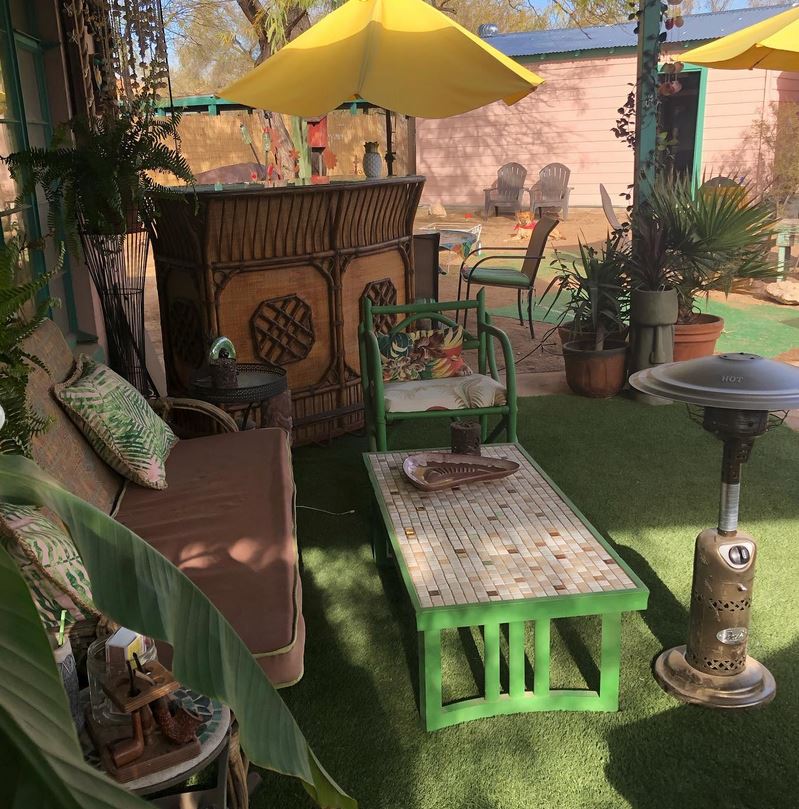
Photo courtesy: Kym Adams
Q. When you first created your awesome rattan patio/tiki bar area, what elements did you need to get the right look? Was it stuff you already had, or did you go out and buy?
A. It evolved. I knew I wanted the Florida/Cuban rattan look. I made layaway payments on some of the pieces to an antique mall in Seattle. Also, a friend in the tiki community had more pieces to offer in Seattle after I had already moved to Tucson, so I paid Shiply to move them down for me. The outdoor bar was on Facebook Marketplace in Tucson, and I made a new friend out of that deal. Most of the other things were found at flea markets and antique malls. I’ve since had people who come in and do odd jobs for us—ask us if we’re from Cuba!
Q. Are there any sources you get ideas from when it comes to decorating? Old print ads? Tiki books? Et cetera?
A. A lot of times, I get ideas from friends’ homes and tiki bars. I get a lot of inspiration from our travels and a few tiki books.
Q. What are your favorite tiki restaurants you’ve tried during your travels?
A. Probably The Mai-Kai in Florida and The Bali Hai in San Diego.
Q. What tropical countries/cities have you traveled to over the years?
A. Jamaica, Key West, Cuba, Kauai, the British Virgin Islands, the French West Indies, and all over Mexico.
TIKI-TASTIC!
Q. Do you ever think, “I gotta slow down and stop collecting so much,” or is it too much fun to stop?
A. At this point, if something comes in, something needs to go. I really have to love it, as our place is very small.
Q. Any fun stories about buying and transferring some of your odder pieces?
A. I have taken very large signs and velvet paintings on planes before 9/11 just by asking flight attendants, “Do you have a closet?” as I’m boarding with the items.
Q. What is the farthest you’ve traveled to get something? And what was it?
A. We drove two hours each way to pick up an amazing bar for our living room. We also did the same for a large Witco carving.
Q. Has anyone ever given you grief about how much you decorate or dress?
A. Only the way I dress. I’ve been asked if I was in a band or a play. I just answered, “Yes!”
Q. Any other non-tropical items you collect?
A. Sometimes I kind of go off the rails, and things get eclectic. In other non-tiki rooms, I have big collections of old vintage cowgirl stuff, Bakelite bangle bracelets, Mexican Day of the Dead stuff, and pink poodles wearing black cat-eye glasses. If I lived in a big house, I’d be afraid of what I would be capable of!
Q. Any special hints for people who wanna go “all in” like you?
A. Start by buying the books The Book of Tiki, Tiki Pop, and Tiki Modern—all by Sven Kirsten. Also, Potions of the Caribbean by Jeff “Beachbum” Berry, Smuggler’s Cove by Martin Cate, The Mai-Kai by Tim Glazner, and finally, Polynesiacs by Tiki Tom-Tom. All will get you excited about tiki. Oh yeah, and start saving money!
For more information, follow Shoobashooba’s tropical lifestyle on her two Instagram pages, @the.chiqui_flamingo.lounge and @shoobashooba, as well as her Facebook page. She also sells on Etsy.
Love tiki décor? Read about one WorthPoint contributor’s longtime hunt for the quintessential tropical fabric: barkcloth.
Jenna Girard has been a freelance writer and copy editor for over 25 years, with a focus on feature writing. A lifelong collector of antiques and collectibles, Jenna has amassed a remarkable collection of entertainment ephemera, vintage fabrics, head vases, and mid-century art and home décor. After 16 years of living in Los Angeles and working in the entertainment industry, Jenna now resides in her home state of Michigan, where she continues to write/copy edit for LA-based media outlets.
WorthPoint—Discover. Value. Preserve.

